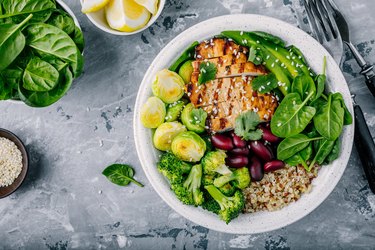
Losing 15 pounds in two months is an ambitious goal, but it's possible if you stick to a focused diet and exercise plan and make some key lifestyle changes.
When you break it down, you'll need to lose about 2 pounds a week, which is at the high end of range for safe weight loss, per the Centers for Disease Control and Prevention.
Video of the Day
Video of the Day
Here's how to make it happen:
1. Create the Right Calorie Deficit
Weight loss is the result of eating fewer calories than you burn — aka creating a calorie deficit. Because a pound of body fat equals about 3,500 calories, you'll need to create a total deficit of 52,500 calories to lose 15 pounds. Divide this number by two months or eight weeks, and you need to make this deficit about 6,563 calories per week, or about 937 calories per day.
There are two ways to create a calorie deficit: Eat fewer calories or burn more calories through exercise (or, ideally, both).
Achieving this deficit solely by eating fewer calories may be an impossible feat. Many adults need between 1,600 and 2,100 calories per day to maintain their current weight, according to the 2020-2025 Dietary Guidelines for Americans. Depriving themselves of 937 calories daily would put them below the 1,200-calorie mark, which is the minimum calories needed for adequate nutrition. Following such a low-calorie diet would also create a sense of deprivation during the two months, making it hard to stick with the diet, and would likely lead to fatigue and a loss of muscle mass.
Most people need to boost their daily calorie burn by adding in more exercise and other extra movement. Indeed, an August 2012 randomized trial in Obesity found that people who combined diet and exercise lost the most weight. (This particular study focused on post-menopausal people with overweight or obesity, for the record.)
Calculate Your Calories
Follow these two steps to create a calorie deficit:
- Figure out your daily caloric requirement — or about how many calories you typically burn — by using a calorie-tracking app. The app takes your age, sex and activity level into account to estimate this number.
- Then use the app to help you determine how many fewer calories you need to eat and how many calories you need to burn through exercise each day to lose 15 pounds in two months.
2. Prioritize Exercise
According to the Physical Activity Guidelines for Americans, adults should aim for at least 150 minutes of moderate-intensity cardio (think: brisk walking or biking) or 75 minutes of vigorous-intensity activity (think: running) each week to maintain good health.
If you're trying to lose weight, and especially if you have an aggressive goal like losing 15 pounds in two months, consider this your minimum amount of weekly aerobic activity.
The number of calories you burn during exercise depends on your size and the intensity and duration of the activity. For example, it takes about an hour of swimming laps, jogging or playing tennis for a 155-pound person to burn 450 to 500 calories, according to Harvard Health Publishing.
Again, a calorie-tracking app can come in handy, to help you keep track of how many calories you're burning per session.
Add in Strength Training
Strength training for weight loss is crucial because it helps offset muscle loss during weight loss and also improves your ability to lose weight. Why? Because muscle burns more calories than fat, which means adding muscle to your frame will help you burn more calories overall.
According to the Physical Activity Guidelines for Americans, adults should aim to do at least two workouts a week that include total-body strength moves. These could be bodyweight moves like squats and push-ups or weight-bearing exercises using free weights or machines (or a combination).
Weight lifting doesn't burn as many calories in the moment as cardio, but you'll get the benefit of excess post-exercise oxygen consumption (EPOC), which means your body will burn more calories than normal for several hours after your workout.
Consider HIIT
If you're short on time, you can burn more calories in fewer minutes by doing high-intensity interval training (HIIT). HIIT combines cardio and strength into one workout that alternates bouts of intense exercise with recovery periods.
3. Move More During the Day
The more you move throughout the day, the more calories you burn, which can help you lose 15 pounds in two months without having to severely restrict your diet.
Instead of sitting and watching TV or scrolling on your phone in your spare time, work in more of the following everyday activities that burn calories:
- Gardening and yard work
- Household chores like vacuuming and dusting
- Hand-washing your car
- Walking — park farther away from stores to get in more steps
- Standing
By doing more of these activities, you could potentially burn hundreds of additional calories each day.
4. Focus on Healthy Foods
Even with additional movement and exercise, you'll most likely need to trim about 500 calories daily to create a deficit large enough to help you lose 15 pounds in two months.
Limit Processed and Sugary Fare
Start by minimizing your consumption of processed foods that are high in added sugars and fats. Refined grains and sweets are a poor source of nutrients and are a leading source of calories in the American diet.
Examples of foods to avoid include:
- Baked goods and other desserts
- White bread and pasta (choose whole-wheat, and keep portion sizes in check)
- Candy
- Soda
- Sweetened breakfast cereal
- Snack crackers and chips
Choose Lean Protein
Opt for leaner cuts of meat instead of marbled steak or processed meats such as sausage and luncheon meats.
Other relatively low-calorie, high-protein foods include:
- Black beans
- Chicken breast
- Cottage cheese (plain, low-fat)
- Eggs
- Greek yogurt (plain, low-fat)
- Halibut
- Salmon
- Shrimp
- Tempeh
- Tofu
- Tuna
Load Up on Veggies and Fruit
Work in generous portions of fruits and vegetables at all meals. Produce is naturally low in calories and high in fiber. Fiber is crucial for weight loss because it helps you feel full and keeps your digestive system running smoothly.
All fruits and veggies are good choices, but the best fruits for weight loss include:
- Apples
- Watermelon
- Berries
- Avocado
- Mangoes
- Pineapple
- Citrus fruit, such as grapefruit and oranges
Snack Wisely
Smart snack choices include:
- A small handful of nuts
- Low-fat yogurt
- Fresh fruit
- Cut-up vegetables
- Whole-grain crackers with low-fat cheese
5. Get Enough Sleep
The National Sleep Foundation recommends adults sleep seven to nine hours of sleep per night to promote a healthy weight.
Lack of sleep can affect weight loss in the following ways:
- It can reduce your levels of leptin, the "I'm full" hormone, which may cause you to overeat.
- It may encourage your body to store more fat.
- It can lower your willpower, making you less likely to stick with your diet and exercise plan.
- Centers for Disease Control and Prevention: "Losing Weight"
- 2020-2025 Dietary Guidelines for Americans
- Obesity: "Effect of diet and exercise, alone or combined, on weight and body composition in overweight-to-obese post-menopausal women"
- National Sleep Foundation: "A Good Night's Sleep Can Help You Maintain a Healthy Weight"
- Physical Activity Guidelines for Americans, 2nd Edition
- Harvard Health Publishing: "Calories burned in 30 minutes for people of three different weights"
- Harvard Health Publications: Calories Burned in 30 Minutes for People of Three Different Weights


